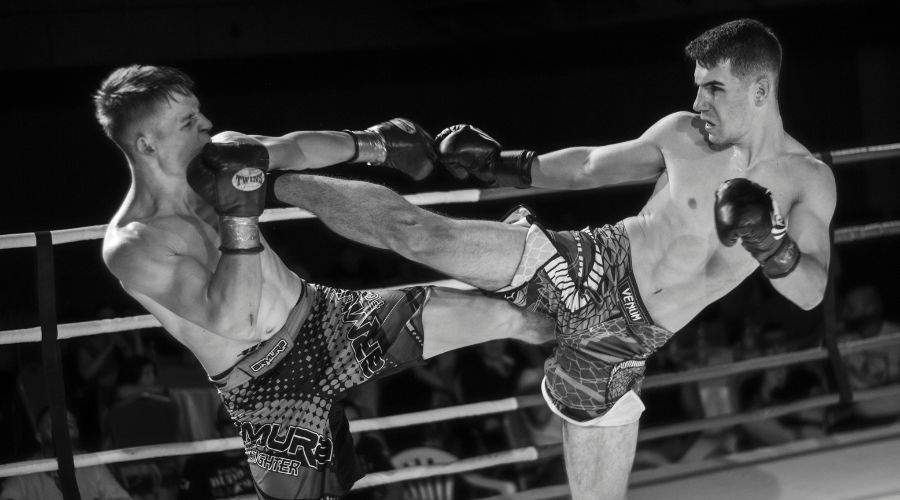The dreaded period sitting on the sideline. We’ve all been there, whether through injury or life circumstances. But this isn’t the only way detraining can occur. Sometimes, fight preparation can be so hectic you quickly reduce your strength and conditioning training volume.
Can this hurt your fight performance? Is detraining something that can happen within a week? It turns out this could be the case. Further, I’ll be challenging the ideas of training residuals made popular by Soviet Sports Scientist Vladimir Issurin.
What Is Detraining?
Detraining is defined as a “partial or complete loss of training induced adaptations as a consequence of training reduction or cessation [1].” In other words, the lack of training stimulus during short (<4 weeks) or long (>4 weeks) periods.
As a fighter, you may experience reduced training or complete rest periods. For example, after a fight or tournament as you take time off. Or an injury that reduces your ability to train. Another example of reduced training is when preparing for a fight or tournament.
During these condensed periods of skills training, you may reduce the volume, intensity, and frequency of strength and conditioning training. Therefore, the question becomes, how little can you do and still retain or improve physical attributes to maximize fight performance?
The follow-up question is, how long does it take to lose physical qualities you’ve developed through training during rest?
The Theory Of Training Residuals
Many coaches use Vladimir Issurin’s Residual Training Effects table to dictate how often to train certain physical qualities. This table was made popular in his Block Periodization books. Here’s how it looks:
| Physical Quality | Residual Training Effect (Days) |
|---|---|
| Aerobic Endurance | 30 ± 5 |
| Maximal Strength | 30 ± 5 |
| Anaerobic Glycolytic Endurance | 18 ± 4 |
| Strength Endurance | 15 ± 5 |
| Maximal Speed | 5 ± 3 |
The Residual Training Effects table shows how long you can not train a particular physical quality and retain your current fitness level. For example, speed and power are the first to detrain when not trained for 5 days on average.

How to Dominate Every Fight with Raw, Explosive Power No One Can Match
Discover the underground blueprint that has quietly turned MMA hopefuls into legends, using nothing but sheer, brute force and bulletproof conditioning techniques.
In contrast, aerobic capacity adaptations can last up to 30 days on average. But there are many problems with these numbers and this table that are rarely discussed. Firstly, the source of this information is dubious at best.
If you trace back the origins of these numbers, they come from an untranslated, German non-peer-reviewed article. This original article does not reference where they got these numbers from. Thus, these ranges may not be based on any evidence.
Secondly, what happens during a detraining period depends on the training performed before the reduction or cessation of training. Thirdly, physical qualities are not trained in isolation, and a workout that improves one quality may also enhance many others.
A good example is a maximal strength training session may signal hypertrophy, improve power development, and develop the anaerobic lactic energy system.
Lastly, recent research demonstrates how different these ranges can be depending on the measured physiological or performance marker.
How Training Affects A Detraining Period

Firstly, how qualities react in a detraining period will depend heavily on what type of training and how much is performed before detraining.
While not a true detraining period, my study from my Master’s thesis implemented a strength training taper near the end of pre-season. All other qualities were trained as usual [2].
During the 21-day taper, only 3 strength training sessions were performed with very low volume and high intensity.
We hypothesized that velocity capabilities would benefit the most from this tapering period due to the overshoot phenomenon of Type IIX muscle fiber [3]. However, we found that force capabilities were the one to rebound from this reduced training volume.
This was likely due to the high volumes of strength training preceding this taper. The same can be seen in endurance-based populations where <4 weeks of detraining has shown declines or maintenance of VO2max with suggestions that the differences in the studies relate to the amount of physical activity performed before the detraining period [1].
Secondly, the retention of physical qualities is dictated by what activity is performed during the detraining period. Now, a true detraining period will be a complete cessation of exercise other than normal daily activity.
While the residual training effect is based on this strict definition, athletes will rarely take more than two weeks entirely off any physical activity (minus serious injury or sickness). This makes the residual training effect less applicable in this situation.
Finally, your training level greatly influences how quickly a physical quality will decline. For example, VO2max declines to a greater degree in those who are highly trained compared to lesser-trained counterparts [4].
Strength follows a similar trend where those who don’t have a large strength base seem to potentially retain strength for longer [5][6]. The same trend is also seen regarding speed, where faster players show a more significant decline in 30m sprint time and repeatability compared to slower players [7].
So now we better understand how prior training and fitness level influence detraining. But quickly do these qualities erode when sinking into the couch for extended periods?
What Are The Real Training Residuals When Detraining?

Not every quality in the residual training effect has been studied, and I will make extrapolations of data and inferences in this section.
Aerobic Training Residuals
Aerobic adaptations to detraining have been studied the most out of these physical qualities. Mujika & Padilla have published a great review on the short-term effects (<4 weeks) of detraining on the cardiorespiratory system [1].
VO2max has been found to decline by 4-14% with short-term detraining. One study in relatively well-trained individuals (average VO2max of 62 ml.kg-1.min-1) saw a decline in aerobic power by 7% in just 12 days of training cessation, where the subjects with the highest initial VO2max saw the most significant drop (some up to 10% in 12 days) [4].
It seems much of the drop in cardiovascular function is due to the 5 to 12% decline in blood and plasma volume, limiting the amount of blood pooled in the heart [1]. In fact, the plasma volume has been observed to drop 5% within 2 days of training cessation in competitive distance runners [8].
As a result of the decline in blood and plasma volume, 5 to 10% increases in heart rate and 10 to 17% declines in stroke volume occur to make up for the lower volume of blood. These adaptations have been seen to happen in as little as 12 to 21 days of training cessation [4].
Unfortunately, the increase in heart rate isn’t enough to make up for the decline in stroke volume. This may have been due to a 12% reduction in left ventricle dimension, which occurred in just 3 weeks of detraining [9].
While these are mainly central adaptations, peripherally, 50% reductions in muscle oxidative capacity have been seen in swimmers in as little as 1 week [4].
What effect does this have on performance? A 4 to 25% shorter time to exhaustion during running has been found in endurance athletes [4]. After just 14 days of cessation of exercise, a 9% reduction in time to exhaustion was found in well-trained endurance athletes [10].
Overall, aerobic capabilities are massively hindered in time frames much shorter than those presented in Issurin’s Residual Training Effects of 30 ± 5 days.
Anaerobic Training Residuals

Anaerobic glycolytic variables are negatively affected in the short term with RER increases at both sub-maximal and maximal exercise [4]. This has been shown in as little as 3 weeks of detraining in recently and well-trained subjects.
Increases in RER track well with increases in blood lactate and anaerobic glycolytic energy contribution [11]. And higher blood lactate levels are seen at sub-maximal swimming intensities in just one week of training cessation in competitive swimmers [12].
Anaerobic glycolytic performance, such as the Wingate, hasn’t been studied that I know of. Still, if we extrapolate the available research noting that anaerobic contributions occur at lower intensities, one could assume that the ability to sustain high-intensity efforts would be diminished potentially even as soon as one week of detraining, especially in highly trained athletes.
Maximal Strength Training Residuals
Maximal strength, similar to anaerobic glycolytic adaptations, hasn’t been studied to the extent of aerobic performance. Three papers have highlighted maximal strength adaptations to detraining.
One found no significant change in bench press and squat 1RM after 14 days of training cessation in well-trained power athletes [13]. Interestingly, some significant slow and fast isokinetic quadricep strength losses were observed.
It’s difficult to speculate why. Perhaps it’s due to power athletes being well-trained in squat and bench press movements, whereas isokinetic exercise would’ve potentially been a new stimulus.
The second paper took elite kayakers who went through a 4-week taper leading into competition [14]. Following the competition, kayakers were split into a 5-week training cessation or reduced training group.
The training cessation group showed reductions in bench press and bench pull to a much greater degree than the reduced training group. However, the results of this study should be taken with a grain of salt when applied to residual training effects.
As I have mentioned, the training performed before training cessation heavily influences detraining adaptations. These athletes had already reduced their training volume for 4 weeks, negatively affecting the reduced training group, who should’ve maintained their strength.
To support this theory, 3 strength training sessions in 21 days significantly improved theoretical maximum force capabilities but not velocity, likely due to the heavy strength training period preceding the reduced training block [2].
Lastly, U20 soccer players were able to retain 1RM leg press strength after 26 days of detraining. These athletes weren’t incredibly strong, so this could have been a case of lesser-trained individuals retaining strength for longer than higher-level athletes [5].
The residual training effect of maximal strength seems highly individual and dependent on the training performed prior to detraining.
Speed Training Residuals
Speed and detraining have been studied even less than other qualities. One study on U20 soccer players found maintenance of 10m sprint velocity after 26 days of detraining [5]. However, this doesn’t touch maximal velocity (ranging from 5-7 m.s-1).
In another study, professional soccer players took a 2-week Christmas break as a training cessation period [15]. During a 30m repeated sprint ability test, they found reductions in best, mean, and total time.
When split into a fast and slow group, the faster group showed greater impairment in sprint performance, indicating faster players lose speed quicker than slower players. The loss in repeated sprint ability is likely due to the rapid declines in aerobic variables, which are essential for recovery between efforts.
How Long Can You Take Off As A Fighter?

Overall, training adaptations’ losses seem to occur faster than the guidelines provided by the residual training effects.
However, with so many variables affecting these timelines, giving a concrete timeline is near impossible and likely doing you a disservice. Especially with how quickly some qualities, such as aerobic adaptations, can decline.
After a fight, you may look to take a week or two off purely as a mental benefit. Not everything has to be about maximizing physical qualities. Further, because you may fight a few times yearly, you have time to retrain qualities that may dip during this time.
When looking at Zatsiorsky’s seminal text in 1995, he details a section on training residuals. However, the only referenced material is a 1966 German study that suggested the faster you gain strength, the quicker you lose it.
It seems this may depend on what is being tested. For example, strength and power athletes training three times per week for 8 years saw significant declines in eccentric isokinetic knee extension torque and fast twitch muscle fiber cross-sectional area while squat and bench press 1RMs were maintained [13].
Collegiate swimmers who undertook a 4-week detraining period after a 5-month competition training period saw no reduction in muscular strength either [12]. But their ability to produce power during swimming significantly declined.
Perhaps concentric strength is maintained longer than eccentric strength and concentric power qualities regardless of the duration of training leading into a detraining period.
Secondly, Zatsiorsky states that mature athletes with extensive training backgrounds have relatively stable training residuals. Meaning they have slow rates of decline and that aerobic qualities and maximal strength are retained longer than anaerobic capacities.
This doesn’t seem to be the case where VO2max declines to a greater degree in those who are highly trained compared to lesser-trained counterparts and occurs within 12 days of detraining [4].
Strength follows a similar trend where those who don’t have a large strength base seem to potentially retain strength for longer [5][6]. The same trend is also seen regarding speed, where faster players show a greater decline in 30m sprint time and repeatability compared to slower players [7].
What is not mentioned is how quickly qualities can be retrained. Zatisorsky states elite athletes can retrain physical abilities faster than less experienced athletes, which I would agree with.
In my experience, we can bounce back faster than we think to our previous maximum abilities when taking an extended period off. This can be as quick as up to 2 months.
There also seems to be a minimum threshold where after years of training, there are specific numbers you’ll be able to hit regardless of your time off.
For example, it could be that you can squat ‘x’ amount of weight no matter how long you take off because of your previous training. This minimum threshold, in my experience, seems to increase as you get stronger.
However, this doesn’t consider the ability to tolerate workload, so while retraining back to maximums is relatively quick, retraining back to tolerating heavy workloads will take longer.
While mainly applicable to detraining periods, the residual training effect is often applied during training periods. Zatisorsky states that specific retaining or detraining loads can be used for different qualities within each training cycle.
For example, in sports where maximal strength isn’t hugely influential such as the striking arts, true maximal strength may only be trained once every 7-14 days to maintain strength qualities and develop other important physical attributes.
But what is not considered is that “everything affects everything.” The power training performed with moderately loaded squat jumps will carry over to getting stronger.
Improving maximal strength is likely to enhance the abilities of the anaerobic glycolytic energy system in some capacity. Further, combat sports training attacks many physical qualities in the gym.
Grappling can be a form of strength training, especially when shooting takedowns or lifting partners. Striking can be a form of speed and power training, especially when throwing hard strikes and short combinations on the bag or pads with long rest. And technical training is a mixture of aerobic and anaerobic energy system development.
Summary
Detraining may occur much faster than training residuals indicate. However, we must remember that unless you’re taking a complete cessation from training, you likely won’t see real-world declines in performance. Further, if you know you’re taking time off, train harder leading into the detraining period, and you may improve performance after time away.
Finally, don’t stress when taking time off after a fight or tournament. It can be refreshing for the mind to break the mental and physical grind that can occur leading to a big event.
References
1. Mujika, I., & Padilla, S. (2000). Detraining: loss of training-induced physiological and performance adaptations. Part I. Sports medicine, 30(2), 79-87.
2. de Lacey, J., Brughelli, M., McGuigan, M., Hansen, K., Samozino, P., & Morin, J. B. (2014). The effects of tapering on power-force-velocity profiling and jump performance in professional rugby league players. The Journal of Strength & Conditioning Research, 28(12), 3567-3570.
3. Andersen, J. L., & Aagaard, P. (2000). Myosin heavy chain IIX overshoot in human skeletal muscle. Muscle & Nerve: Official Journal of the American Association of Electrodiagnostic Medicine, 23(7), 1095-1104.
4. Coyle, E. F., Martin 3rd, W. H., Sinacore, D. R., Joyner, M. J., Hagberg, J. M., & Holloszy, J. O. (1984). Time course of loss of adaptations after stopping prolonged intense endurance training. Journal of Applied Physiology, 57(6), 1857-1864.
5. Pereira, L. A., Freitas, T. T., Pivetti, B., Alcaraz, P. E., Jeffreys, I., & Loturco, I. (2020). Short-Term Detraining Does Not Impair Strength, Speed, and Power Performance in Elite Young Soccer Players. Sports, 8(11), 141.
6. García-Pallarés, J., Sanchez-Medina, L., Pérez, C. E., Izquierdo-Gabarren, M., & Izquierdo, M. (2010). Physiological effects of tapering and detraining in world-class kayakers. Medicine and science in sports and exercise, 42(6), 1209-1214.
7. Rodríguez-Fernández, A., Sánchez-Sánchez, J., Ramirez-Campillo, R., Rodríguez-Marroyo, J. A., Villa Vicente, J. G., & Nakamura, F. Y. (2018). Effects of short-term in-season break detraining on repeated-sprint ability and intermittent endurance according to initial performance of soccer player. PLoS One, 13(8), e0201111.
8. Cullinane, E. M., Sady, S. P., Vadeboncoeur, L., Burke, M. I. C. H. A. E. L., & Thompson, P. D. (1986). Cardiac size and VO2max do not decrease after short-term exercise cessation. Medicine and science in sports and exercise, 18(4), 420-424.
9. Martin, W. H., Coyle, E. F., Bloomfield, S. A., & Ehsani, A. A. (1986). Effects of physical deconditioning after intense endurance training on left ventricular dimensions and stroke volume. Journal of the American College of Cardiology, 7(5), 982-989.
10. Houmard, J. A., Hortobagyi, T., Johns, R. A., Bruno, N. J., Nute, C. C., Shinebarger, M. H., & Welborn, J. W. (1992). Effect of short-term training cessation on performance measures in distance runners. International journal of sports medicine, 13(08), 572-576.
11. Bertuzzi, R., Nascimento, E. M., Urso, R. P., Damasceno, M., & Lima-Silva, A. E. (2013). Energy system contributions during incremental exercise test. Journal of sports science & medicine, 12(3), 454.
12. Neufer, P. D., Costill, D. L., Fielding, R. A., Flynn, M. G., & Kirwan, J. P. (1987). Effect of reduced training on muscular strength and endurance in competitive swimmers. Medicine and Science in Sports and Exercise, 19(5), 486-490.
13. Hortobágyi, T. I. B. O. R., Houmard, J. A., Stevenson, J. R., Fraser, D. D., Johns, R. A., & Israel, R. G. (1993). The effects of detraining on power athletes. Medicine and science in sports and exercise, 25(8), 929-935.
14. Izquierdo-Gabarren, M., & Izquierdo, M. I. K. E. L. (2010). Physiological effects of tapering and detraining in world-class kayakers. Med Sci Sports Exerc, 42(6), 1209-1214.
15. Rodríguez-Fernández, A., Sánchez-Sánchez, J., Ramirez-Campillo, R., Rodríguez-Marroyo, J. A., Villa Vicente, J. G., & Nakamura, F. Y. (2018). Effects of short-term in-season break detraining on repeated-sprint ability and intermittent endurance according to initial performance of soccer player. PLoS One, 13(8), e0201111.

